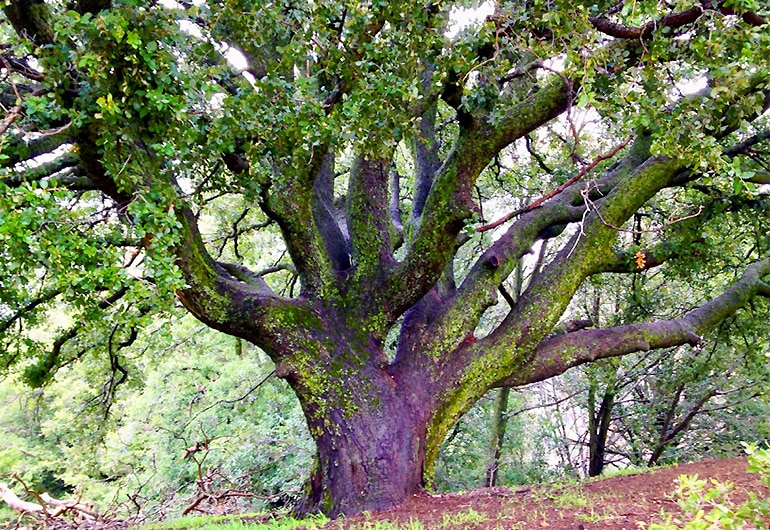This is the last full week of January. As such, I think it’s not too late to consider and resolve to live better this year. Here I share my ‘Tree of Life’ metaphor/model for implementing resolutions. We all know they are easier made than kept. The Tree of Life Metaphor/Model consists of three parts; the trunk, crown, and roots.
The trunk is where your day-to-day awareness and thinking live. This is your ‘self,’ including the thoughts you have about your life, changes you’d like to make, problems you face, and your feelings and desires, etc.
The crown represents everything that transcends the current ‘you’ with your current concerns and points of view. The crown represents your transcendent or ultimate concerns, the values you choose to live by, the core and abiding lifegoals you follow, and your connection to God and/or the cosmos.
The roots represent the day-to-day of your life, the very mundane problems you face and the way you (actually) spend your time. If the crown is all that is transcendent, then the roots are the immanent, your life lived facing all that arises in its everydayness.
Now that I’ve introduced these three aspects of life, let me explain how they can all work together to improve your chances of resolution follow through and, perhaps, the quality of what you resolve in the first place.
Let’s start with the crown. As the representation of the transcendent, it can act as that which you consult when considering and choosing life changes for 2022. A resolution requires a concrete plan for the activities you will now regularly engage in and/or activities you will now consistently refrain from. For example, let’s say the very first thought that comes to mind concerning a 2022 resolution is “I want to lose 20 pounds.” Sure, why not? So, now you can consult your crown and ask yourself why that’s so important to you. We both know losing 20 pounds (and keeping it off) will require substantial changes and times of discomfort. So, there must be countervailing reasons that more than offset the necessarily uncomfortable changes you are considering making. Your reasons for losing 20 pounds can be of whatever kind but, whatever they are, they need to be powerful enough to maintain your motivation through thick and thin. Your reason for weight loss gains power through its alignment with and being an instantiation of your core goals and values. So, what reason, one that transcends your current wish to lose weight, will sustain that wish and connect it with something deeply important to you? Perhaps one reason is that you want to live in a way to survive long enough to be a grandparent to your children or to set a healthy example for your children or, because you believe that your life is a gift, that it is your job to honor and sustain yourself with healthful behaviors.
Such considerations of what transcends you in the current moment can lead to new thinking about changes you’d like to make that you had not before considered. And once you make your resolution, you can make a habit of referring to your transcendent values to maintain their connection with your concrete resolution. If you find you can’t connect the change you’re considering to anything of central concern to you, then maybe that change isn’t worth undertaking or, at least, it is not the priority.
Now that you have resolved to undertake a change in the way you live and tied it with what’s crucially important, you’re still left with deploying it in your everyday life. If something is to change, that means the nature of your activities must change, including how you make decisions and spend your time. Now we focus on the roots of your Tree of Life, the representation of day-to-day living, choosing and acting. Although there is much that can be said here, let me keep this simple: we are all familiar with the saying ‘a place for everything and everything in its place’ as an aphorism to remind ourselves (and family) to keep things tidy. A version of this can be used for deploying resolutions: ‘A time and place for every activity and every activity in its time and place.’ What this means is that when you make a resolution, one that changes the activities you undertake and undergo during your every day, those activities must be done sometime during the day and in some location. Well, of course!
This concept is so simple, yet frequently ignored. Let’s look at another straight-forward resolution to see how grounding your resolution works. Let’s say you resolve to regularly engage in cardio workouts. Your health is suffering, and you need change. You decide to get that health club membership you’ve been thinking about the past five years and promise yourself you’ll go there three times a week. Great. Why not?
But now what? One clue to the challenge is that you’ve been thinking about joining a health club for a long time and never did anything about it. Why not? There are reasons for this, even if you would rather not face them. Maybe you have too little time. Maybe you are often exhausted after work. Maybe you have a lot of family and other responsibilities that use up your time and energy. And maybe, despite your self-protestations, getting healthy by running on a treadmill is simply not compelling enough to get out there, in the heat or the cold, to go running in place. So, what will be different this time? Well, we’ve already established at this point that you have connected your resolution with your transcendent concerns. But, unless you find the time and the place for your cardio workouts, they will not take hold. Like most, your attendance at the health club will likely lapse by April. So, ask yourself, “When will I go? Before work?” If so, are you willing or able to get up, oh, an hour earlier? Or maybe you’ll go after work? Or later in the evening? But will you have the time to keep it up? The energy? So, maybe you realize you need to let go of other activities. Maybe your life is already too packed and adding without subtracting is not a winning strategy. Are you willing to let something else go? If so, what will it be?
And let’s also consider place. It seems that joining a health club is not strictly necessary to getting on a treadmill. Maybe it’s better to buy one instead. Or, better still, maybe it’s better to run outside. But maybe that may feel unsafe. But, perhaps, you can get together with friends and form a jogging or marathon training club and run together. It’s safer and more motivating. Now, all members work to motivate (and shame) each other.
So, when making a resolution, consider the transcendent crown and the immanent roots of every day in which your new activity must be grounded. This exercise in thinking can clarify and strengthen both your resolutions and your resolve.
Above photo: this photo is of one of my favorite trees. It’s my friend. What, you don’t have a favorite tree? Well, get one! That could be this year’s resolution. I believe this tree is a Coast Live Oak or Quercus agrifolia, and it lives on the side of Volcan Mountain in eastern San Diego County. I visit as frequently as I can, as good friends should do.
Thanks,
Dr. Jack
Language Brief
“Wisdom is of the soul, is not susceptible of proof, is its own proof.” ― Walt Whitman
“We travel, some of us forever, to seek other states, other lives, other souls.” ― Anais Nin
“Your actions are your only true belongings.” ― Allan Lokos
“We need a coat with two pockets. In one pocket there is dust, and in the other pocket there is gold. We need a coat with two pockets to remind us who we are.” ― Parker J. Palmer







Leave A Comment